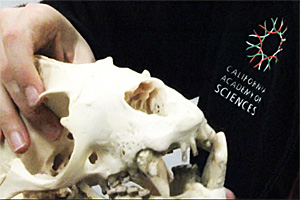 Moe Flannery, Collections Manager for Ornithology & Mammalogy at Cal Academy shows us some jaws that didn’t move too well in life.If a dead marine mammal washes up on our beaches, from Bodega Bay to Año Nuevo, the California Academy of Sciences Department of Ornithology & Mammalogy gets a call. They’ve been part of the Marine Mammal Stranding Network since 1982, a federal research program run by the National Marine Fisheries Service to investigate strandings, conduct biological monitoring, and coordinate the collection of specimens for study.
Moe Flannery, Collections Manager for Ornithology & Mammalogy at Cal Academy shows us some jaws that didn’t move too well in life.If a dead marine mammal washes up on our beaches, from Bodega Bay to Año Nuevo, the California Academy of Sciences Department of Ornithology & Mammalogy gets a call. They’ve been part of the Marine Mammal Stranding Network since 1982, a federal research program run by the National Marine Fisheries Service to investigate strandings, conduct biological monitoring, and coordinate the collection of specimens for study.
QUEST recently went across town to spend the afternoon with Moe Flannery, Collections Manager for Ornithology & Mammalogy at Cal Academy. She invited us over for a bit of sleuthing with some of her favorite skull & bone specimens from the sea. By comparing the skulls of healthy animals to those who met an untimely death, and factoring in evidence from the report and scene of the stranding, Moe can often formulate a story of what may have happened to the animal, as well as surmise larger patterns in it’s population and ecosystem.
We started with California Sea Lions (Zalophus californianus), an abundant pinniped in our Northern California waters. The Cal Academy has over 28,500 mammal specimens in their vast collection, including 3000 California sea lion skulls. Some of the specimens– such as those with injuries (such as shark bites or broken bones) or congenital deformities, certainly pulled at my heartstrings, But, seeing animals that had been killed (or had their death hastened) due to “human interaction” definitely got my hackles up. In our video we take a look at 2 examples of human interaction, but sadly they are not the only two examples in the collection.
My favorite skull by far was the beastly and beautiful adult male Northern Elephant Seal (Mirounga angustirostris). Although they are no slouch with the flesh intact, without such they made the black bear skull on the table look positively puny. At up to 14 feet long and 5,000 pounds in size, they are in fact the largest mammal breeding in the San Francisco Bay area.
One of the most fascinating skulls we saw in the Cal Academy collection actually did not make it into our video. At one point during our behind-the-scenes tour, Moe had us help her pull down a heavy, coffin-shaped wooden box. She opened the top to reveal a 5-plus-foot-long skull of an elderly female Killer Whale (Orcinus orca). Although associated more with the Northwest, orcas are found off of our shores as well, and every once in a while wash up on the beach. Moe was able to guess at the age in part by looking at the condition of the teeth. The teeth of the lower jaw were worn down to mere nubs, that would have likely been sitting at or below the gum line. Not much use for catching fish. It is surprising that she was able to live that long without a decent bite, but given the high level of social organization in orca pods, perhaps not. Some researchers have observed these whales sharing their catch with each other.
In this Episode
In our second episode of Science on the SPOT, join us on a behind-the-scenes trip deep into the massive collection of marine mammal skulls at the California Academy of Sciences in San Francisco. You’d be surprised how much you can learn about an animal’s life– and death– by reading their bones. For your viewing pleasure, we’ve embedded a blog-sized version here. If you’d like to embed it on your blog (pretty please), go to the story page and grab the embed code.
